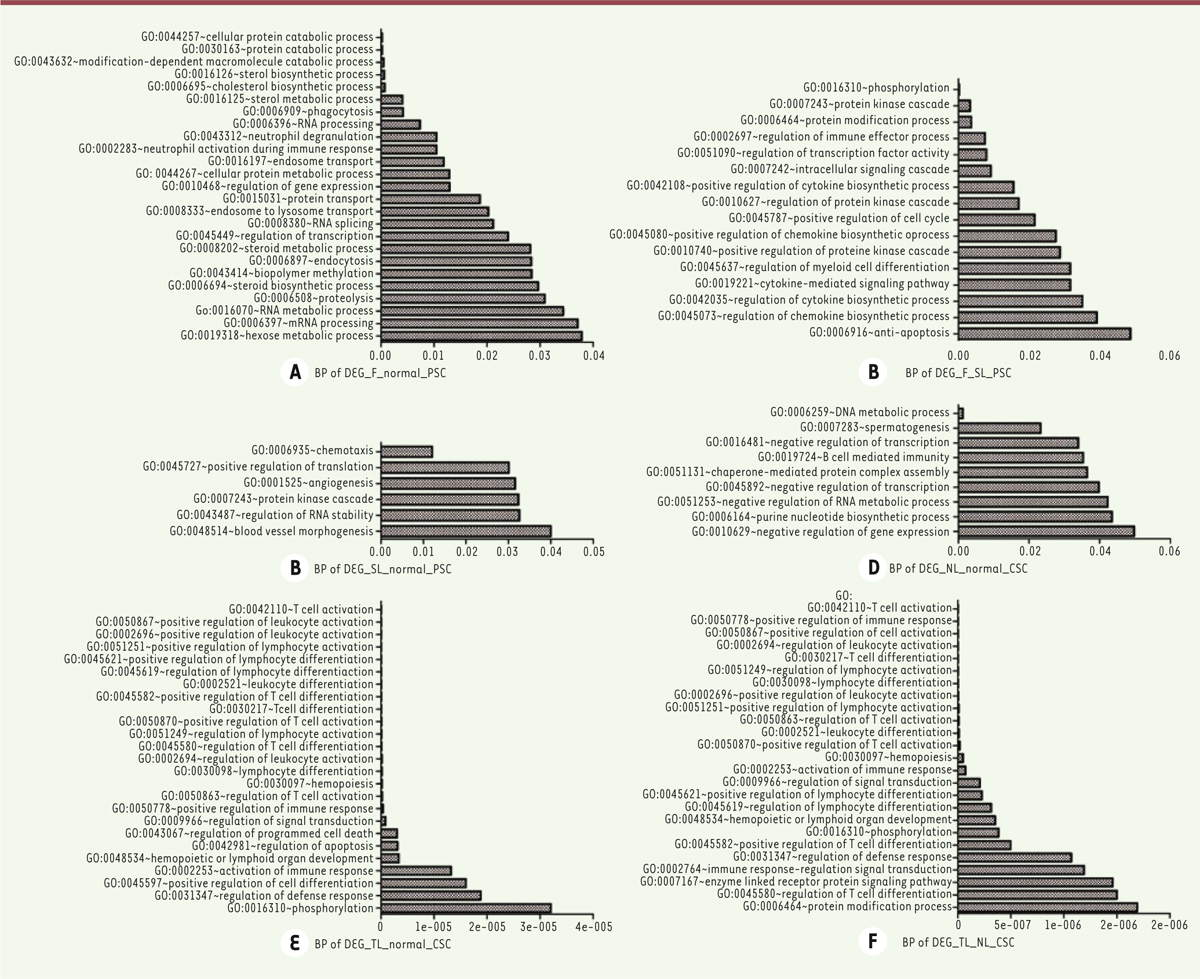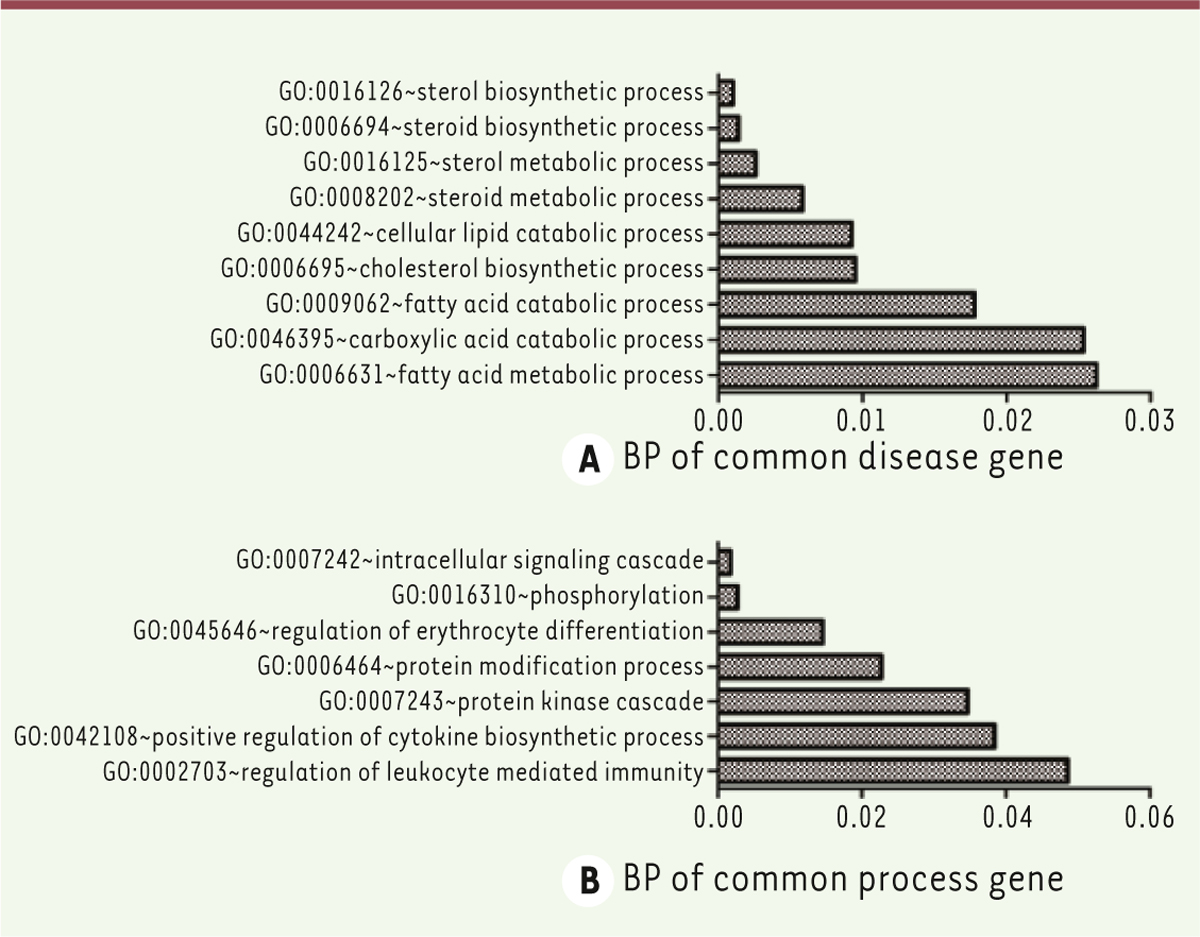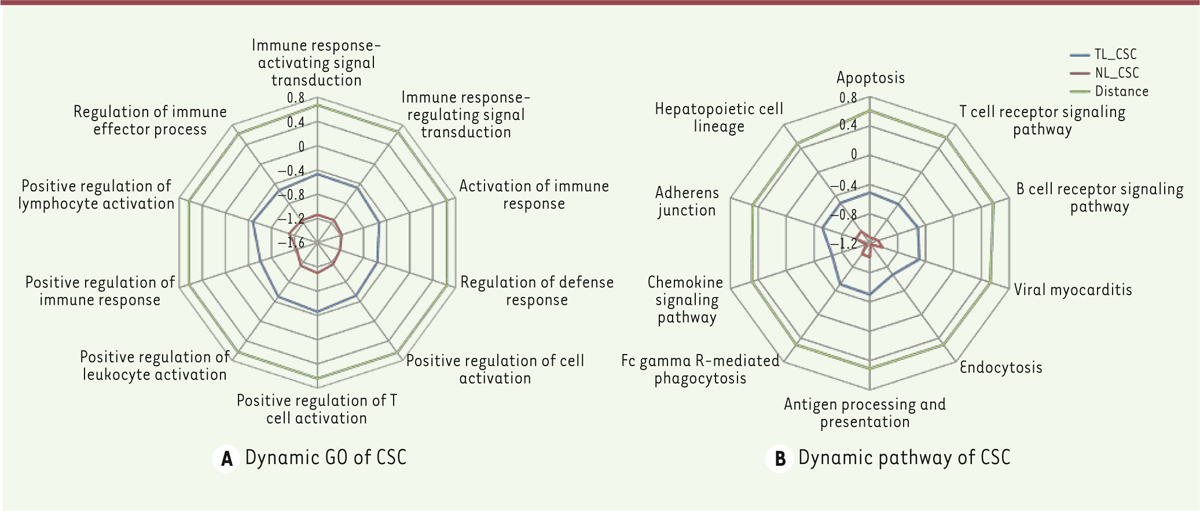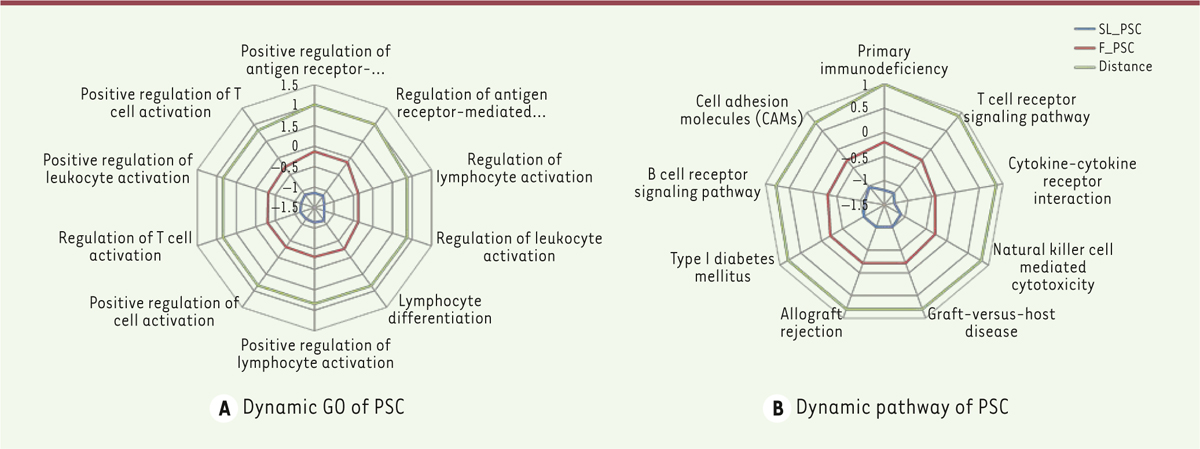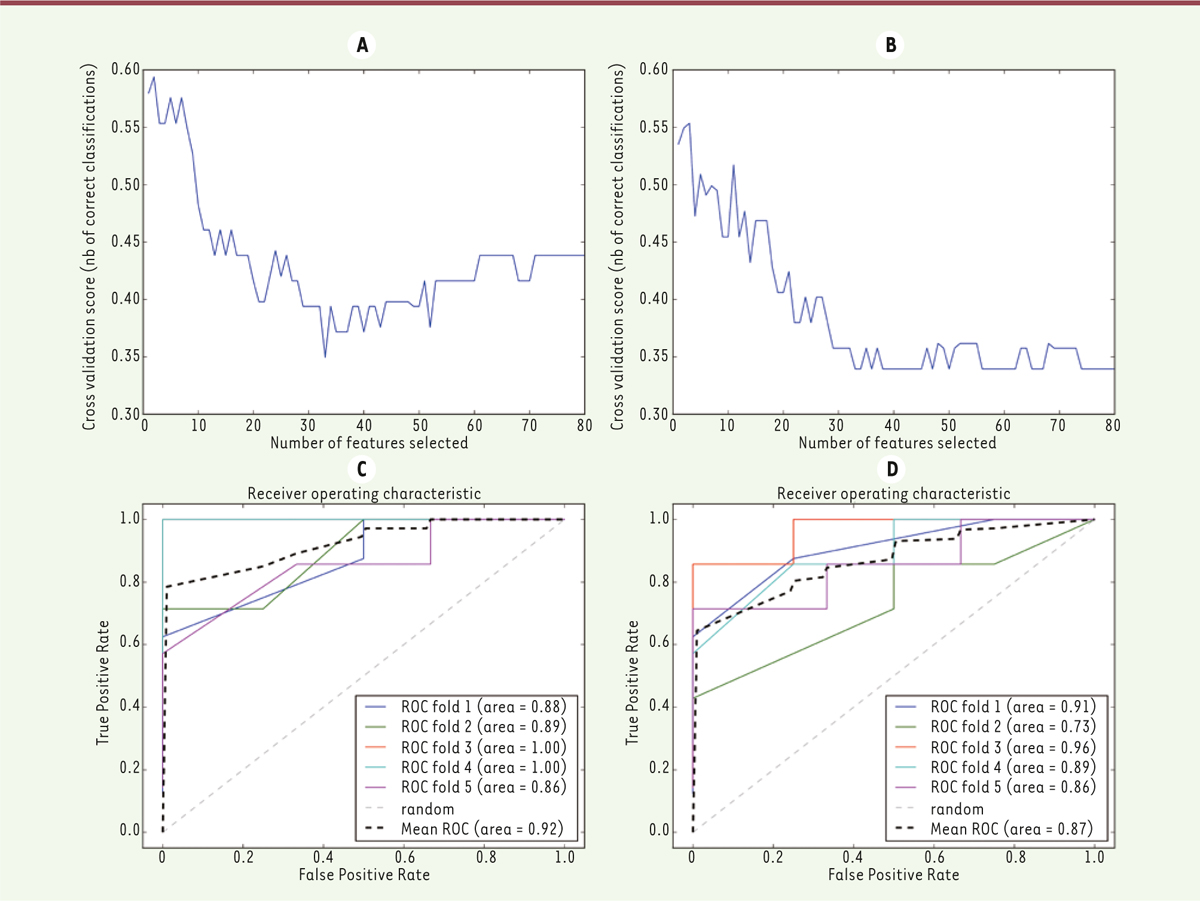| GO:0009074~aromatic amino acid family catabolic process |
-0.15 |
-0.18 |
0.03 |
|
| GO:0043065~positive regulation of apoptosis |
-0.78 |
-1.32 |
0.54 |
|
| hsa04062:chemokine signaling pathway |
-0.66 |
-1.15 |
0.49 |
|
| GO:0051050~positive regulation of transport |
-0.65 |
-1.08 |
0.43 |
|
| GO:0031328~positive regulation of cellular biosynthetic process |
-0.87 |
-1.3 |
0.43 |
|
| GO:0006935~chemotaxis |
-0.64 |
-1.12 |
0.48 |
|
| GO:0030097~hemopoiesis |
-0.71 |
-1.26 |
0.55 |
|
| GO:0008360~regulation of cell shape |
-0.48 |
-1.07 |
0.59 |
|
| hsa04612:Antigen processing and presentation |
-0.5 |
-1.01 |
0.51 |
|
| GO:0016477~cell migration |
-0.72 |
-1.13 |
0.41 |
|
| GO:0043067~regulation of programmed cell death |
-0.92 |
-1.39 |
0.47 |
|
| GO:0000904~cell morphogenesis involved in differentiation |
-0.66 |
-1.07 |
0.41 |
|
| GO:0007409~axonogenesis |
-0.61 |
-1.03 |
0.42 |
|
| GO:0008202~steroid metabolic process |
-0.46 |
-0.61 |
0.15 |
|
| GO:0032944~regulation of mononuclear cell proliferation |
-0.51 |
-1.12 |
0.61 |
|
| GO:0002694~regulation of leukocyte activation |
-0.67 |
-1.25 |
0.58 |
|
| GO:0030278~regulation of ossification |
-0.45 |
-0.93 |
0.48 |
|
| GO:0002526~acute inflammatory response |
-0.47 |
-0.98 |
0.51 |
|
| GO:0050867~positive regulation of cell activation |
-0.52 |
-1.16 |
0.64 |
|
| hsa04666:Fc gamma R-mediated phagocytosis |
-0.51 |
-1.02 |
0.51 |
|
| GO:0002757~immune response-activating signal transduction |
-0.47 |
-1.14 |
0.67 |
|
| GO:0002696~positive regulation of leukocyte activation |
-0.5 |
-1.13 |
0.63 |
|
| GO:0060548~negative regulation of cell death |
-0.74 |
-1.18 |
0.44 |
|
| GO:0010740~positive regulation of protein kinase cascade |
-0.58 |
-1.07 |
0.49 |
|
| hsa04660:T cell receptor signaling pathway |
-0.54 |
-1.12 |
0.58 |
|
| GO:0044106~cellular amine metabolic process |
-0.52 |
-0.67 |
0.15 |
|
| GO:0050778~positive regulation of immune response |
-0.61 |
-1.24 |
0.63 |
|
| hsa04514:Cell adhesion molecules (CAMs) |
-0.63 |
-1.08 |
0.45 |
|
| GO:0051260~protein homooligomerization |
-0.55 |
-0.96 |
0.41 |
|
| GO:0048812~neuron projection morphogenesis |
-0.64 |
-1.07 |
0.43 |
|
| hsa05220:Chronic myeloid leukemia |
-0.5 |
-0.93 |
0.43 |
|
| GO:0006520~cellular amino acid metabolic process |
-0.47 |
-0.61 |
0.14 |
|
| GO:0031325~positive regulation of cellular metabolic process |
-0.91 |
-1.34 |
0.43 |
|
| GO:0051222~positive regulation of protein transport |
-0.45 |
-0.95 |
0.5 |
|
| GO:0048534~hemopoietic or lymphoid organ development |
-0.72 |
-1.27 |
0.55 |
|
| GO:0002695~negative regulation of leukocyte activation |
-0.5 |
-1.07 |
0.57 |
|
| GO:0022008~neurogenesis |
-0.84 |
-1.27 |
0.43 |
|
| hsa04144:Endocytosis |
-0.67 |
-1.18 |
0.51 |
|
| GO:0006334~nucleosome assembly |
-0.42 |
-0.45 |
0.03 |
|
| GO:0000902~cell morphogenesis |
-0.75 |
-1.2 |
0.45 |
|
| GO:0010604~positive regulation of macromolecule metabolic process |
-0.91 |
-1.34 |
0.43 |
|
| GO:0050870~positive regulation of T cell activation |
-0.46 |
-1.1 |
0.64 |
|
| GO:0051174~regulation of phosphorus metabolic process |
-0.81 |
-1.27 |
0.46 |
|
| GO:0048732~gland development |
-0.6 |
-0.85 |
0.25 |
|
| GO:0008544~epidermis development |
-0.67 |
-1 |
0.33 |
|
| hsa02010:ABC transporters |
-0.24 |
-0.39 |
0.15 |
|
| GO:0002449~lymphocyte mediated immunity |
-0.45 |
-1.03 |
0.58 |
|
| GO:0030098~lymphocyte differentiation |
-0.54 |
-1.09 |
0.55 |
|
| GO:0070663~regulation of leukocyte proliferation |
-0.51 |
-1.12 |
0.61 |
|
| GO:0048666~neuron development |
-0.71 |
-1.17 |
0.46 |
|
| hsa04810:Regulation of actin cytoskeleton |
-0.66 |
-1.14 |
0.48 |
|
| GO:0042110~T cell activation |
-0.6 |
-1.12 |
0.52 |
|
| GO:0006694~steroid biosynthetic process |
-0.42 |
-0.59 |
0.17 |
|
| GO:0032268~regulation of cellular protein metabolic process |
-0.82 |
-1.27 |
0.45 |
|
| GO:0051249~regulation of lymphocyte activation |
-0.62 |
-1.22 |
0.6 |
|
| GO:0007243~protein kinase cascade |
-0.76 |
-1.2 |
0.44 |
|
| GO:0030335~positive regulation of cell migration |
-0.51 |
-0.92 |
0.41 |
|
| GO:0019220~regulation of phosphate metabolic process |
-0.81 |
-1.27 |
0.46 |
|
| GO:0032990~cell part morphogenesis |
-0.68 |
-1.12 |
0.44 |
|
| GO:0051223~regulation of protein transport |
-0.56 |
-1 |
0.44 |
|
| GO:0048699~generation of neurons |
-0.82 |
-1.25 |
0.43 |
|
| GO:0046394~carboxylic acid biosynthetic process |
-0.46 |
-0.61 |
0.15 |
|
| GO:0048858~cell projection morphogenesis |
-0.67 |
-1.11 |
0.44 |
|
| hsa00982:Drug metabolism |
-0.32 |
-0.43 |
0.11 |
|
| hsa04910:Insulin signaling pathway |
-0.6 |
-1.01 |
0.41 |
|
| GO:0008284~positive regulation of cell proliferation |
-0.8 |
-1.27 |
0.47 |
|
| GO:0050670~regulation of lymphocyte proliferation |
-0.5 |
-1.12 |
0.62 |
|
| GO:0048706~embryonic skeletal system development |
-0.26 |
-0.42 |
0.16 |
|
| GO:0033157~regulation of intracellular protein transport |
-0.49 |
-0.95 |
0.46 |
|
| GO:0001942~hair follicle development |
-0.18 |
-0.36 |
0.18 |
|
| GO:0043068~positive regulation of programmed cell death |
-0.78 |
-1.32 |
0.54 |
|
| GO:0019752~carboxylic acid metabolic process |
-0.67 |
-0.81 |
0.14 |
|
| GO:0007242~intracellular signaling cascade |
-1 |
-1.47 |
0.47 |
|
| GO:0045596~negative regulation of cell differentiation |
-0.67 |
-1.11 |
0.44 |
|
| GO:0006464~protein modification process |
-1.02 |
-1.44 |
0.42 |
|
| hsa04640:Hematopoietic cell lineage |
-0.52 |
-1 |
0.48 |
|
| hsa04060:Cytokine-cytokine receptor interaction |
-0.7 |
-1.17 |
0.47 |
|
| GO:0016126~sterol biosynthetic process |
-0.31 |
-0.49 |
0.18 |
|
| GO:0035136~forelimb morphogenesis |
-0.11 |
-0.28 |
0.17 |
|
| hsa00280:Valine, leucine and isoleucine degradation |
-0.27 |
-0.45 |
0.18 |
|
| GO:0031175~neuron projection development |
-0.68 |
-1.13 |
0.45 |
|
| GO:0045937~positive regulation of phosphate metabolic process |
-0.51 |
-0.94 |
0.43 |
|
| GO:0031399~regulation of protein modification process |
-0.71 |
-1.17 |
0.46 |
|
| GO:0030217~T cell differentiation |
-0.46 |
-1 |
0.54 |
|
| GO:0009966~regulation of signal transduction |
-0.94 |
-1.4 |
0.46 |
|
| GO:0009967~positive regulation of signal transduction |
-0.71 |
-1.21 |
0.5 |
|
| GO:0051250~negative regulation of lymphocyte activation |
-0.49 |
-1.05 |
0.56 |
|
| hsa04360:Axon guidance |
-0.6 |
-1.07 |
0.47 |
|
| GO:0032386~regulation of intracellular transport |
-0.51 |
-0.98 |
0.47 |
|
| hsa05416:Viral myocarditis |
-0.49 |
-1.02 |
0.53 |
|
| GO:0007167~enzyme linked receptor protein signaling pathway |
-0.78 |
-1.21 |
0.43 |
|
| GO:0002521~leukocyte differentiation |
-0.58 |
-1.14 |
0.56 |
|
| GO:0048514~blood vessel morphogenesis |
-0.64 |
-1.16 |
0.52 |
|
| GO:0019400~alditol metabolic process |
-0.15 |
-0.3 |
0.15 |
|
| GO:0051251~positive regulation of lymphocyte activation |
-0.48 |
-1.11 |
0.63 |
|
| GO:0009888~tissue development |
-0.87 |
-1.3 |
0.43 |
|
| GO:0022604~regulation of cell morphogenesis |
-0.61 |
-1.21 |
0.6 |
|
| hsa00100:Steroid biosynthesis |
-0.19 |
-0.38 |
0.19 |
|
| GO:0048729~tissue morphogenesis |
-0.63 |
-1.06 |
0.43 |
|
| GO:0050863~regulation of T cell activation |
-0.59 |
-1.18 |
0.59 |
|
| GO:0046395~carboxylic acid catabolic process |
-0.4 |
-0.5 |
0.1 |
|
| GO:0006333~chromatin assembly or disassembly |
-0.45 |
-0.5 |
0.05 |
|
| hsa04210:Apoptosis |
-0.51 |
-1.12 |
0.61 |
|
| GO:0048667~cell morphogenesis involved in neuron differentiation |
-0.62 |
-1.04 |
0.42 |
|
| GO:0042981~regulation of apoptosis |
-0.92 |
-1.39 |
0.47 |
|
| GO:0006633~fatty acid biosynthetic process |
-0.35 |
-0.49 |
0.14 |
|
| GO:0006695~cholesterol biosynthetic process |
-0.25 |
-0.42 |
0.17 |
|
| GO:0009063~cellular amino acid catabolic process |
-0.33 |
-0.44 |
0.11 |
|
| GO:0051347~positive regulation of transferase activity |
-0.65 |
-1.17 |
0.52 |
|
| GO:0051090~regulation of transcription factor activity |
-0.53 |
-1 |
0.47 |
|
| GO:0006631~fatty acid metabolic process |
-0.49 |
-0.63 |
0.14 |
|
| GO:0016310~phosphorylation |
-0.91 |
-1.36 |
0.45 |
|
| GO:0051259~protein oligomerization |
-0.65 |
-1.06 |
0.41 |
|
| hsa00350:Tyrosine metabolism |
-0.31 |
-0.36 |
0.05 |
|
| GO:0009310~amine catabolic process |
-0.36 |
-0.47 |
0.11 |
|
| GO:0070201~regulation of establishment of protein localization |
-0.6 |
-1.04 |
0.44 |
|
| GO:0008285~negative regulation of cell proliferation |
-0.78 |
-1.25 |
0.47 |
|
| GO:0065004~protein-DNA complex assembly |
-0.43 |
-0.46 |
0.03 |
|
| hsa00640:Propanoate metabolism |
-0.17 |
-0.35 |
0.18 |
|
| GO:0032868~response to insulin stimulus |
-0.55 |
-1.07 |
0.52 |
|
| GO:0030099~myeloid cell differentiation |
-0.51 |
-1.05 |
0.54 |
|
| GO:0009952~anterior/posterior pattern formation |
-0.35 |
-0.52 |
0.17 |
|
| GO:0010647~positive regulation of cell communication |
-0.72 |
-1.19 |
0.47 |
|
| GO:0009891~positive regulation of biosynthetic process |
-0.87 |
-1.31 |
0.44 |
|
| GO:0030334~regulation of cell migration |
-0.61 |
-1.07 |
0.46 |
|
| GO:0006355~regulation of transcription, DNA-dependent |
-0.81 |
-0.96 |
0.15 |
|
| GO:0002764~immune response-regulating signal transduction |
-0.48 |
-1.14 |
0.66 |
|
| hsa00480:Glutathione metabolism |
-0.29 |
-0.42 |
0.13 |
|
| GO:0051272~positive regulation of cell motion |
-0.53 |
-0.95 |
0.42 |
|
| GO:0045597~positive regulation of cell differentiation |
-0.69 |
-1.19 |
0.5 |
|
| hsa00061:Fatty acid biosynthesis |
-0.09 |
-0.2 |
0.11 |
|
| GO:0002237~response to molecule of bacterial origin |
-0.5 |
-1 |
0.5 |
|
| GO:0050866~negative regulation of cell activation |
-0.52 |
-1.04 |
0.52 |
|
| hsa04520:Adherens junction |
-0.52 |
-1 |
0.48 |
|
| GO:0007398~ectoderm development |
-0.68 |
-1.02 |
0.34 |
|
| GO:0010942~positive regulation of cell death |
-0.78 |
-1.33 |
0.55 |
|
| hsa00650:Butanoate metabolism |
-0.2 |
-0.35 |
0.15 |
|
| GO:0034728~nucleosome organization |
-0.43 |
-0.48 |
0.05 |
|
| GO:0032496~response to lipopolysaccharide |
-0.48 |
-0.97 |
0.49 |
|
| GO:0010562~positive regulation of phosphorus metabolic process |
-0.51 |
-0.94 |
0.43 |
|
| GO:0015698~inorganic anion transport |
-0.37 |
-0.53 |
0.16 |
|
| GO:0002253~activation of immune response |
-0.53 |
-1.18 |
0.65 |
|
| hsa04662:B cell receptor signaling pathway |
-0.51 |
-1.08 |
0.57 |
|
| GO:0009081~branched chain family amino acid metabolic process |
-0.11 |
-0.27 |
0.16 |
|
| GO:0050868~negative regulation of T cell activation |
-0.45 |
-1.01 |
0.56 |
|
| GO:0002697~regulation of immune effector process |
-0.53 |
-1.15 |
0.62 |
|
| GO:0051246~regulation of protein metabolic process |
-0.85 |
-1.29 |
0.44 |
|
| GO:0006558~L-phenylalanine metabolic process |
-0.11 |
-0.13 |
0.02 |
|
| GO:0031347~regulation of defense response |
-0.56 |
-1.21 |
0.65 |




